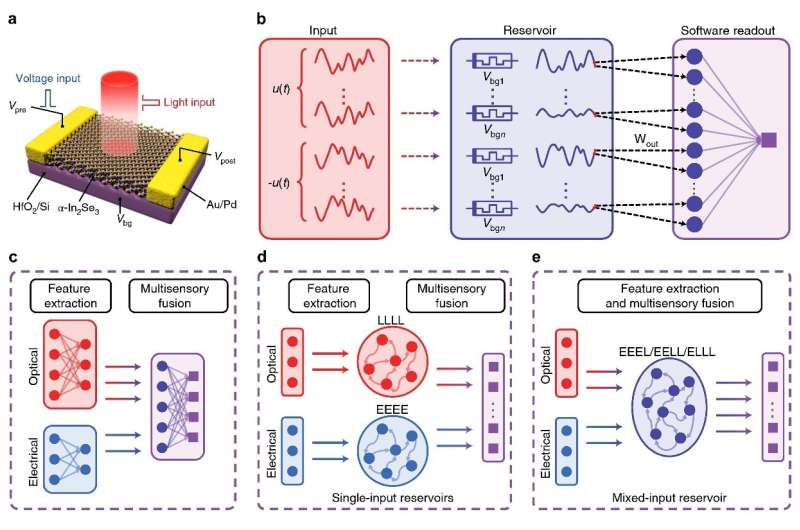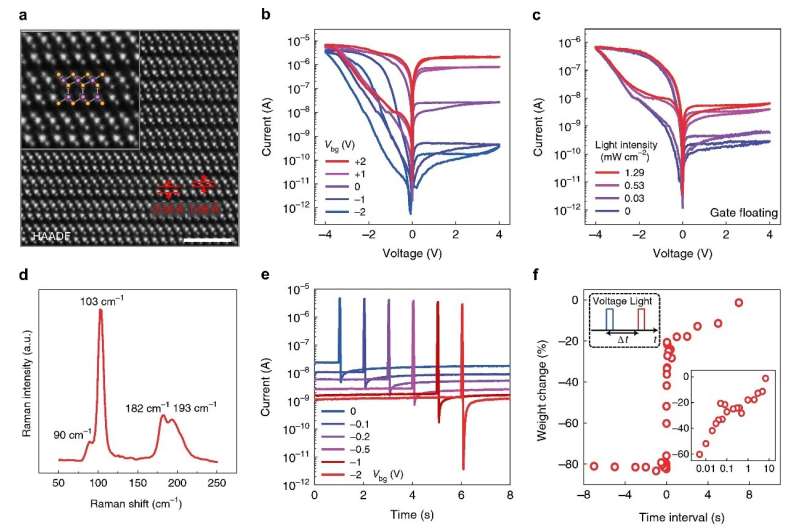A promising optoelectronic synapse for reservoir computing based on alpha-indium selenide
November 15, 2022
feature

Reservoir computing is an emerging computation framework based on the use of recurrent neural networks (i.e., networks in which data persists or reoccurs in patterns). This framework has the potential of reducing the time of data processing, while also improving the energy-efficiency of neuromorphic devices.
Researchers at Peking University and the Beijing Academy of Artificial Intelligence have recently introduced a new artificial synapse based on alpha-indium selenide (α-In2Se3 ), which could help to re-create biological neural processes in neuromorphic devices more effectively. This synapse, introduced in a paper published in Nature Electronics, could have very valuable implications for reservoir computing applications.
“Our idea came from the need for a simple strategy that can be used to exploit the dynamic responses of a physical system for computing, and physical reservoir computing is a promising framework to realize this goal,” Yuchao Yang, one of the researchers who carried out the study, told TechXplore.
“In2Se3 is a very interesting material and a good platform for reservoir computing, and its rich physical properties support the creation of multimode and multiscale reservoir computing systems, which we hope will expand the application scenarios of physical reservoir computing.”
Reservoir computing relies on the use of artificial synapses that can run deep learning algorithms directly, without having to transfer data between a memory and a processing unit. The van der Waals semiconducting material α-In2Se3 has numerous advantageous optoelectronic, ferroelectric, and semiconducting properties, which make it an ideal candidate for fabricating these artificial synapses.
“In2Se3 has two interesting inherent physical properties simultaneously, that is, ferroelectric switching and optoelectronic response,” Yang explained. “We built a planar device to utilize the in-plane ferroelectric polarizations for electrical synapse, while also introducing light as the third terminal to enable optoelectronic response. This unique structure effectively combines the two physical properties and can exploit the coupling of ferroelectric and optoelectronic for heterosynaptic plasticity and higher-level computing functionalities.”

The temporal dynamics of the optoelectronic synapse created by this team of researchers can be controlled using electrical and optical stimuli. This means that it can ultimately artificially replicate the brain’s innate plasticity (i.e., the ability to adapt over time), while also directly processing information.
“A large majority of previous research on neuromorphic computing only used the device as a nonvolatile element, whereas we take advantage of more complex nonlinear dynamics to empower computing,” Yang said.
“Compared with previous reservoir systems with fixed mechanism and functions, our optoelectronic synapse possesses both ferroelectric and optoelectronic properties, thus providing two distinct and physically coupled mechanisms for reservoir computing. This allowed us to realize a reservoir computing system based on mixed-signal input, demonstrating great tunability and enhanced network performance, while here multiscale signal processing is achieved by modulating the relaxation time of the device with light or back-gate voltage.”
To evaluate their artificial synapse’s performance, Yang and his colleagues used to build a multimode reservoir computing system. They then tested this system’s performance in a handwritten digit recognition task and a QR code recognition task. They found that it achieved promising results, successfully tackling both these data processing tasks with accuracies above 80%.
The artificial synapse realized as part of this study could soon open new interesting possibilities for reservoir computing. In addition, the reservoir computing system created using this synapse could be developed further to tackled other complex information processing and data analysis tasks.
“Our demonstration of multimode and multiscale reservoir computing system fundamentally expands the processing capability of reservoir computing systems,” Yang added. “In our recent study, we focused on computing applications, but in the future, we would also like to realize a fully-integrated neuromorphic system, including the sensing of information.”
Keqin Liu et al, An optoelectronic synapse based on α-In2Se3 with controllable temporal dynamics for multimode and multiscale reservoir computing, Nature Electronics (2022). DOI: 10.1038/s41928-022-00847-2
© 2022 Science X Network
Citation:
A promising optoelectronic synapse for reservoir computing based on alpha-indium selenide (2022, November 15)
retrieved 15 November 2022
from https://techxplore.com/news/2022-11-optoelectronic-synapse-reservoir-based-alpha-indium.html
This document is subject to copyright. Apart from any fair dealing for the purpose of private study or research, no
part may be reproduced without the written permission. The content is provided for information purposes only.
For all the latest Technology News Click Here
For the latest news and updates, follow us on Google News.
